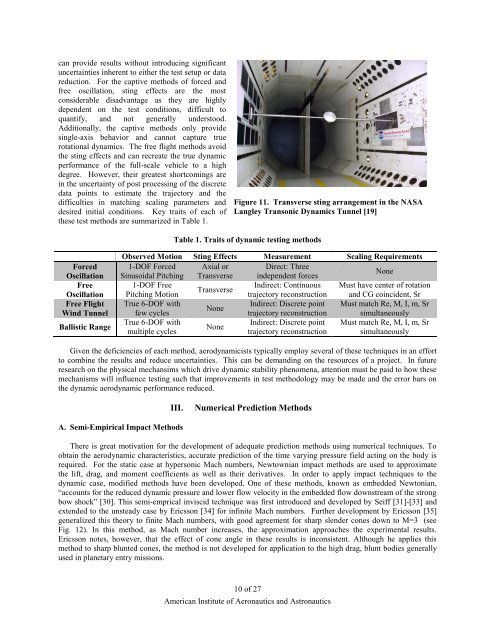Survey of Blunt Body Dynamic Stability in Supersonic Flow
Survey of Blunt Body Dynamic Stability in Supersonic Flow
Survey of Blunt Body Dynamic Stability in Supersonic Flow
Create successful ePaper yourself
Turn your PDF publications into a flip-book with our unique Google optimized e-Paper software.
can provide results without <strong>in</strong>troduc<strong>in</strong>g significant<br />
uncerta<strong>in</strong>ties <strong>in</strong>herent to either the test setup or data<br />
reduction. For the captive methods <strong>of</strong> forced and<br />
free oscillation, st<strong>in</strong>g effects are the most<br />
considerable disadvantage as they are highly<br />
dependent on the test conditions, difficult to<br />
quantify, and not generally understood.<br />
Additionally, the captive methods only provide<br />
s<strong>in</strong>gle-axis behavior and cannot capture true<br />
rotational dynamics. The free flight methods avoid<br />
the st<strong>in</strong>g effects and can recreate the true dynamic<br />
performance <strong>of</strong> the full-scale vehicle to a high<br />
degree. However, their greatest shortcom<strong>in</strong>gs are<br />
<strong>in</strong> the uncerta<strong>in</strong>ty <strong>of</strong> post process<strong>in</strong>g <strong>of</strong> the discrete<br />
data po<strong>in</strong>ts to estimate the trajectory and the<br />
difficulties <strong>in</strong> match<strong>in</strong>g scal<strong>in</strong>g parameters and<br />
desired <strong>in</strong>itial conditions. Key traits <strong>of</strong> each <strong>of</strong><br />
these test methods are summarized <strong>in</strong> Table 1.<br />
Figure 11. Transverse st<strong>in</strong>g arrangement <strong>in</strong> the NASA<br />
Langley Transonic <strong>Dynamic</strong>s Tunnel [19]<br />
Table 1. Traits <strong>of</strong> dynamic test<strong>in</strong>g methods<br />
Forced<br />
Oscillation<br />
Free<br />
Oscillation<br />
Free Flight<br />
W<strong>in</strong>d Tunnel<br />
Ballistic Range<br />
Observed Motion St<strong>in</strong>g Effects Measurement Scal<strong>in</strong>g Requirements<br />
1-DOF Forced Axial or Direct: Three<br />
None<br />
S<strong>in</strong>usoidal Pitch<strong>in</strong>g Transverse <strong>in</strong>dependent forces<br />
1-DOF Free<br />
Indirect: Cont<strong>in</strong>uous Must have center <strong>of</strong> rotation<br />
Transverse<br />
Pitch<strong>in</strong>g Motion<br />
trajectory reconstruction and CG co<strong>in</strong>cident, Sr<br />
True 6-DOF with<br />
Indirect: Discrete po<strong>in</strong>t Must match Re, M, I, m, Sr<br />
None<br />
few cycles<br />
trajectory reconstruction simultaneously<br />
True 6-DOF with<br />
Indirect: Discrete po<strong>in</strong>t Must match Re, M, I, m, Sr<br />
None<br />
multiple cycles<br />
trajectory reconstruction simultaneously<br />
Given the deficiencies <strong>of</strong> each method, aerodynamicists typically employ several <strong>of</strong> these techniques <strong>in</strong> an effort<br />
to comb<strong>in</strong>e the results and reduce uncerta<strong>in</strong>ties. This can be demand<strong>in</strong>g on the resources <strong>of</strong> a project. In future<br />
research on the physical mechansims which drive dynamic stability phenomena, attention must be paid to how these<br />
mechanisms will <strong>in</strong>fluence test<strong>in</strong>g such that improvements <strong>in</strong> test methodology may be made and the error bars on<br />
the dynamic aerodynamic performance reduced.<br />
III.<br />
Numerical Prediction Methods<br />
A. Semi-Empirical Impact Methods<br />
There is great motivation for the development <strong>of</strong> adequate prediction methods us<strong>in</strong>g numerical techniques. To<br />
obta<strong>in</strong> the aerodynamic characteristics, accurate prediction <strong>of</strong> the time vary<strong>in</strong>g pressure field act<strong>in</strong>g on the body is<br />
required. For the static case at hypersonic Mach numbers, Newtownian impact methods are used to approximate<br />
the lift, drag, and moment coefficients as well as their derivatives. In order to apply impact techniques to the<br />
dynamic case, modified methods have been developed. One <strong>of</strong> these methods, known as embedded Newtonian,<br />
“accounts for the reduced dynamic pressure and lower flow velocity <strong>in</strong> the embedded flow downstream <strong>of</strong> the strong<br />
bow shock” [30]. This semi-emprical <strong>in</strong>viscid technique was first <strong>in</strong>troduced and developed by Seiff [31]-[33] and<br />
extended to the unsteady case by Ericsson [34] for <strong>in</strong>f<strong>in</strong>ite Mach numbers. Further development by Ericsson [35]<br />
generalized this theory to f<strong>in</strong>ite Mach numbers, with good agreement for sharp slender cones down to M=3 (see<br />
Fig. 12). In this method, as Mach number <strong>in</strong>creases, the approximation approaches the experimental results.<br />
Ericsson notes, however, that the effect <strong>of</strong> cone angle <strong>in</strong> these results is <strong>in</strong>consistent. Although he applies this<br />
method to sharp blunted cones, the method is not developed for application to the high drag, blunt bodies generally<br />
used <strong>in</strong> planetary entry missions.<br />
10 <strong>of</strong> 27<br />
American Institute <strong>of</strong> Aeronautics and Astronautics
















